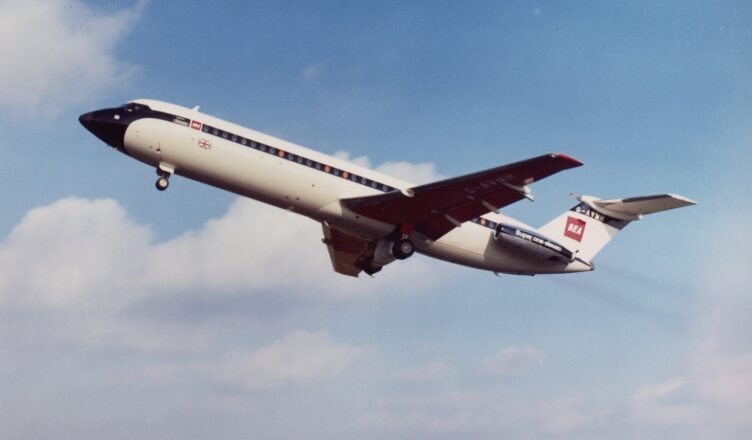Initially conceived by Hunting Aircraft, the BAC1-11 became one of the most popular short-range commercial jet airliners.
BAe Systems Heritage

The BAC One-Eleven was one of the most successful medium-range jet airliner built in UK. Initially conceived by Hunting Aircraft featuring 30-seats was later incorporated into the newly constituted British Aircraft Corporation in 1960.A project born in 1950s when, despite the uncertainties about the reliability of the earlier models, passengers demand was high for jet propulsion
In 1956, British European Airways (BEA) called for a “second generation” short to medium-haul jet aircraft to operate on turboprop flown routes. Most interesting replies came from Hunting Aircraft, proposing a 30-seats jet-powered aircraft virtually replacing Vickers Viscounts (named Hunting 107), and from Vickers, proposing a 140-seats version of their own VC10, named VC11.
A Race to the Market
Following the merging of Vickers-Armstrong, Bristol, Hunting and English Electric into British Aircraft Corporation (BAC), both projects were kept alive and proposed on market. Hunting 107 was initially re-designed into BAC 107 featuring a stretched fuselage seating now 59 passengers and powered by two Bristol Siddeley turbofan engines however market researches proved the aircraft to be too small for the requirements of a quickly developing travel economy.
In 1961 a new, third one, re-design took place to accommodate 80 passengers. Weight issues of the new design prompted a steer into the powerplant as well, the Hawker Siddeley BS75 engines were replaced by the more powerful Rolls-Royce Speys low-bypass turbofans.
The model was re-designated BAC 111 (BAC One-Eleven) and all other projects, including the VC11, were dropped in favour of this.

A Steer into the Commercial Policy
Up to then all commercial aircraft manufacturers in UK based their developments on requirements set from the two State-owned companies of the Kingdom (BEA and BOAC).

With the commercialisation and market researches of the One-Eleven, BAC opened to a wider market including the US one. This lead to an aircraft design flexibility never seen before although the One-Eleven was perfectly suitable to replace turboprops on some of the most busy regional routes in Europe and Overseas.
Unlike other aircraft entering the market, the BAC1-11 was not designed for any specific sector of the airline market and certainly not with one single airline in mind. This made the aircraft very flexible and in fact, it was anticipated that sales orders may reach or even exceed 400 aircraft.
The US Problems
Although it was immediately clear that the BAC1-11 would hold a number of important technological advantages against the likes of the Douglas DC9, the authorities in the United States still withheld their permission for US-based airlines to purchase foreign aircraft. Confidence remained high however, with further pre-orders arriving almost weekly and in July 1963 American Airlines (who had finally broken the restrictions) added another 15 aircraft to their requirement, taking their total order to 60.
Citing directly BAC (and BAe Heritage sources)
The First of the Class
BAC One-Eleven suffered quite some issues during initial testing. The first prototype was tragically lost on October 1963 while test-flying stall characteristics, however not only full development continued but the BAC engineers designed what will become a new aviation standard “stick-shaker and stick-pusher” in the flight controls.
Several improvement of the initial design of the aircraft became standard engineering in the future of aviaiton, as well.
A Various Life

With pre-launch orders already building steadily, the BAC1-11 Series 200 prototype (G-ASHG) flew for the first time from Hurn on 20th August 1963.
Reaching certification in early 1965 the first BAC 1-11 G-ASJI was handed over the launch customer BUA on January 22nd, 1965. his was followed in July 1965 by the introduction of the BAC1-11 Series 400, primarily aimed at the US market.
A stretched BAC One-Eleven Series 500 (or Super One-Eleven) flew on June 30th, 1967 and increased the passenger capacity from 79 to 119 passengers, making the aircraft even more cost-effective and popular on European Inter-City routes, as well as with the new package holiday operators.
A Series 400 version (identified as 475) was specifically designed for hot & high or short field operations in 1970, however quite some competitors came on the market by that time and only some units were effectively built.
Several BAC 1-11 were brought to a second-life – after being dismissed by main airlines – in the charter World strongly developing in the later 1970s , especially thru Europe.
Some of those then became – in their third or fourth life – testbeds for avionic or aerodynamic systems or other experimental units for militaries and civil purposes.
In the end a total of 244 aircraft were built, including the Romanian license-built Rombac 1-11. Quite some still flown up to the early 2000s, especially in the developing countries. The very last flying one still in service was retired by Northrop Grumman after being used as a testbed for the F35 programme on May 6th , 2019.
The BAC 1-11 Series 800, a 150-seater version proposed after BAC and Hawker Siddeley merged into British Aerospace (BAe) in 1977 never seen the light, suffering from strong competition coming from US and European based manufacturer with the advanced models such as the initial designs of the Airbus 320 and the commercial viable Boeing 737.
Safety Records
According to Aviation Safety Network, BAC One-Eleven family was involved into 52 occurrences of which 31 resulted in an hull-loss.
A tons of further information about the BAC One-Eleven can be found over here and on their Facebook page here.

